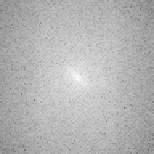Image Processing Reference
In-Depth Information
(a)
(b)
(c)
(d)
FIGURE 10.3
(a) Untagged image (multiplied by a windowing function to avoid edge
effects). (b) FT of untagged image. (c) Image modulated by cosine function. (d) FT of
the modulated image, showing two peaks.
The MR signal is usually acquired in k-space (spatial frequency space), with
the spatial image given by a 2-D Fourier transform (F T) of the k-space signal.
It is useful to examine the effect of tagging on the k-space data. The amplitude
modulation of the spatial image with a cosine is equivalent to a convolution of
the k-space data with the frequency space representation of a cosine, which
consists of two peaks at either side of the origin (Figure 10.3).
Multiple RF pulses separated by gradients were then designed [14] to make
the saturation profile thinner and more square (as in the delays alternating with
nutations for tailored excitation [DANTE] sequence [15]). This results in a graphic
visualization of tagged-spin motion as dark stripes in the image (Figure 10.4).
10.2.3
C
SPAMM
OMPLEMENTARY
An interesting variant of the SPAMM sequence was introduced by Fischer et al.
[16], in which two spin preparation pulses and resulting images are acquired in
series. The first acquires the 1-1 SPAMM image and the second acquires an inverted
1-1 SPAMM image, by changing the sign of the last 90
°
nonselective RF pulse
(
Figure 10.5
).
These two images can then be subtracted to enhance the tagged signal, and
eliminate the signal due to T1 relaxation. Initially proposed to improve tag contrast,
FIGURE 10.4
Five-pulse SPAMM-tagging sequence. (a) ED, (b) end-systole, and (c) late
diastole.











































Search WWH ::

Custom Search